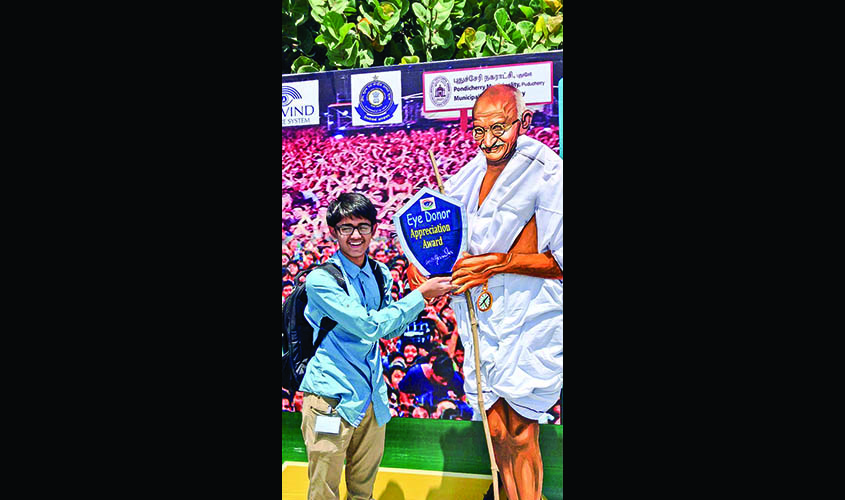What makes them special is their working on India projects and on issues that are most pressing—finding potable drinking water and curing blindness.
Washington DC: India celebrated its 70th Republic Day on Saturday. I was sitting nearly 7,500 miles away in Washington DC and other than my usual sat, sat naman (greetings) to the motherland on this day, I have an interesting observation to lift many hearts with emotion—India is alive and cherished in the hearts of Indian American kids.
Catching up with the community last weekend, I had the chance to interact with Indian families in real Indian style on food, music and some political “charcha”. I came across two Indian-origin kids, Sujay Swain and Avyuk Dixit, who grabbed my attention for the sheer works they have done for India.
Sujay and Avyuk are both high school students from East Coast’s top institutions with extraordinary academic records and have a detailed competition schedule always working in their minds. What made them special was their working on India projects and on issues that are most pressing—finding potable drinking water and curing blindness.
Sujay, a Grade 10 student of Montgomery Blair School in Maryland State, comes from a family with strong Indian roots in Karnataka and Odisha. His father is a physicist and mother is an engineer. He says one summer of 2016 changed his outlook towards India and he got “completely involved in a mission mode”.
Says Sujay: “During that trip of 2016, we visited our ancestral village in Karnataka where I saw people drinking water out of a contaminated stream. This was the same water where waste was being deposited. Coming from America, where clean water is taken for granted, this was a shocker for me. Clean water not accessible to citizens? Shocking!”
That was a hard reality for him about India and it didn’t end there. “When I returned to the US, I did some research on the topic and I found out that nearly one million people around the world die each year due to water-related illness and 60% of all people in this world do not have access to clean water. But, further research showed that many of the water purification techniques currently used are very expensive and impractical to use in affected areas. India is no exception to this, hence, people prefer the contaminated supply.”
Sujay’s research also showed that the only solution currently being used with limited success is SODIS (Solar water disinfection). SODIS was developed by a group, Eawag, the Swiss Federal Institute of Aquatic Sciences and Technology, but has many limitations and takes a long time (two-four days) to purify water.

“I decided to develop a low-cost water purification method with available waste products and cheap resources. My method costs less than $5 (Rs 350) per family annually and effectively removes physical, chemical and biological contaminants in water. India is the second largest producer of sugarcane. Densely packed sugarcane bagasse can filter water for physical impurities and activated carbon, created by burning extracted sugarcane juice with CaCl can remove chemical impurities, like lead and chromium.”
For biological purification, Sujay developed an innovative solution using a linear parabolic reflector design to concentrate UV-A and Infrared radiation from sunlight on the water source, to enhance SODIS (Solar water disinfection). “The synergistic effect between higher temperature (55°C) and UV-A created an environment in which E. Coli could not survive and the purification time for water reduced from two-four days with traditional SODIS process to six-eight hours with this new method. Through a series of systematic experiments, acceptable standards for safe drinking water were achieved,” he said.
Avyuk, a Grade 11 student from Thomas Jefferson High School for Science & Technology, has his roots in the Hindi heartland of Uttar Pradesh. His passion to find a viable health remedy for growing glaucoma is purely personal. “After learning that my uncle living in New Delhi had contracted glaucoma, a leading cause of blindness worldwide, I decided to apply my passion for computer science to create an affordable, early detection machine learning model that could diagnose glaucoma from mere fundus images of the eye. I took my model to Aravind Eye Hospital, Puducherry, to help integrate it with their infrastructure at vision centres and potentially eye camps,” Avyuk told The Sunday Guardian.
His research and findings amazed me. “Many ophthalmologists regularly measure intraocular pressure to determine whether a patient is at risk of glaucoma, however these tests are arbitrary and can be inaccurate, as the ‘normal’ intraocular pressure varies over ethnicity and age. Some doctors may also take fundus images of patients’ eyes, helping to reveal the thickness of their optic nerve.”
Avyuk, who had his mentoring at Johns Hopkins University on this health issue, said: “My project uses machine learning, the study of mathematical models that computer systems use to progressively improve their performance on any task, to classify fundus images of the eye as healthy or glaucomatous. This novel algorithm would mainly be used for the preliminary screening of patients, making processes more efficient and cost effective.”
His Electronic Medical Records (EMRs) done on thousands of patients he researched are now coming to the aid of Aarvind Hospital, which is now using it for treatment.
Recalling his days in Puducherry, he says: “I witnessed live eye surgeries and saw the effect glaucoma and eye disease had on patients in the most remote villages… A lot is required to cure those suffering from this.”
What next? Sujay now wants to collaborate with the local government in his ancestral village in Karnataka and with governments of similarly affected regions in India. He plans to visit India this summer to put his research proposal for testing. Avyuk is refining his findings and researching on how to best monitor the next level—progress of glaucoma in confirmed patients. “That’s even a more difficult stage for patients,” he says.
Prime Minister Narendra Modi’s “Make in India” push gets some champion contenders!

